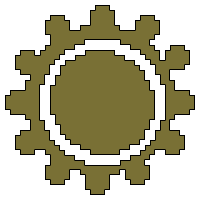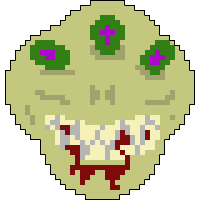
In D&D 5e, there are 14 different monster types:
- Aberration
- Beast
- Celestial
- Construct
- Dragon
- Elemental
- Fey
- Fiend
- Giant
- Humanoid
- Monstrosity
- Ooze
- Plant
- Undead
A “monster type” in D&D is essentially a classification that gives you additional information about the monster. On their own, monster types do not mean anything in particular. However, certain abilities and items reference monster types – giving either an additional affect or no affect at all.
For example: the spell Blight does not affect Undead or Constructs, but if a Plant is targeted it has disadvantage against the save and takes maximum damage.
In today’s article I’ll give a short-and-sweet description of each of these monster types, and you’ll get a preview of my tremendously tremendous Photoshop skills.
(the video ended up being longer than 5 minutes… sorry!)
Aberration
“Seriously, what the actual fuck?!”
Aberrations are spooky monsters that probably originated in either outer space or the depths of the ocean. They might often use their alien brains instead of their brawn to pew-pew you to death. Aberrations also have approximately 300% more tentacles than other monster types.
Examples of Aberrations Include:
- Flumph
- Gibbering Mouther
- Mind Flayer
- Beholder
- Nothic

Beast
“What does the fox say?”
Creatures that we would probably call animals in real life are referred to as ‘Beasts’ in D&D 5e. Some of these beasts are tiny and cute, while others are really big and mean. You might be able to make a traveling companion, but you might get torn to shreds as the rest of the party bails.
Examples of Beasts Include:
- Bears, Boars, Bats
- Dinosaurs
- Miniature Giant Space Hamsters
- Almiraj (also known as bunny unicorns)

Celestial
“Holier than thou”
Beings from the Heavens that serve and act as messengers of the Gods are called Celestials in D&D 5e. Celestials are almost always Good when it comes to alignment, and they just might make you feel all warm and fuzzy inside (if you’re not a murderhobo, that is).
Examples of Celestials Include:
- Solar
- Pegasus
- Deva
- Ki-Rin

Construct
“Processing…Processing…Critical Error!”
If the castle from Beauty and the Beast existed in D&D, it would be full of monsters with the Construct type. Constructs are essentially inanimate objects that have been brought to life through magical means. Most Constructs do not possess any true intelligence and simply perform the task they were built for, such as passing the butter.
Examples of Constructs Include:
- Rug of Smothering
- Monodrones
- Animated Armor
- Flesh Golem

Dragon
“Never laugh at live Dragons”
Dragons are an absolute staple of D&D and the fantasy genre. Monsters of this type have breathe weapons (among other things), are very large, can fly, and tend to hoard gold and treasures. Typically speaking, chromatic dragons tend to be evil while metallic dragons tend to be good.
Examples of Dragons Include:
- Young Red Dragon
- Ancient Gold Dragon
- Dragon Turtle
- Faerie Dragon

Elemental
“Storm, Earth, and Fire… Heed my call!”
D&D monsters of the elemental type are living creatures that are composed of pure natural chaos (fire, earth, air, water). The pure elementals are no joke and might ring your bell, but there are also smaller versions of lesser elements called Mephits that resemble imps. Also Genies and Gargoyle are elementals.
Examples of Elementals Include:
- Fire Elemental
- Smoke Mephit
- Djinni
- Phoenix

Fey
“The world ain’t all rainbows and sunshine”
Fey creatures tend to inhabit the lands of enchanted forests and never-ending twilight (Feywild). Monsters of the Fey type include creatures from common folklore, both good and evil. They might make a soup out of your children, or they might just dance and sing in a state of pure whimsy.
Examples of Fey Include:
- Satyr
- Pixie
- Green Hag
- Dryad

Fiend
“Dance with the Devil”
If Celestials represent everything that is good, Fiends absolutely represent everything that is evil and twisted. Fiends didn’t hear enough words of affirmation when they were growing up, and now they’re going to make you feel their pain.
Examples of Fiends Include:
- Nycaloth
- Cambion
- Pit Fiend
- Erinyes

Giant
“Hulk smash!”
Giants are very similar to people, except for… well, they’re giant. In D&D 5e, there is a variety of Giant types that have their own social structure and hierarchy (called the Ordning). Some of them live in clouds, while others inhabit icy tundras or fiery caverns.
Examples of Giants Include:
- Storm Giant
- Fire Giant
- Frost Giant
- Troll
- Ogre

Humanoid
“To err is human”
In D&D 5e, any type of monster or creature that is close enough to a human (or a human mixed with something else) is called a humanoid. They’ll typically have their own social structures, languages, and culture. Humanoids is a broad category that includes the majority of playable races, as well as common low-level enemies.
Examples of Humanoids Include:
- Orcs
- Tabaxi
- Kobold
- Goblins

Monstrosity
“Scary monsters don’t have plaque!”
If an Aberration and a Beast matched on Tinder, the outcome would probably look like a Monstrosity. These types of monsters, are exactly that: monsters. With few exceptions, they’ll try to gobble you right up.
Examples of Monstrosities Include:
- Owlbear
- Chimera
- Hydra
- Tarrasque

Ooze
“Jiggle-Me-Jello”
Oozes are essentially – to quote Charlie Kelly – ‘your basic slimes, your sludges…slippery things’. They’re little amorphous blobs that absorb and dissolve adventurers. Compared to the other monster types in D&D 5e, Oozes are an incredibly small category.
Examples of Oozes Include:
- Gelatinous Cube
- Black Pudding
- Ochre Jelly
- Gray Ooze

Plant
“I’m rooting for you”
I can’t think of a clever way to describe plants when it comes to D&D monster types. You probably already know what a plant is (spoiler alert: they have a cell wall and contain chloroplasts). They’re just like that, except a bit more sentient. The more you know!
Examples of Plants Include:
- Treants
- Assassin Vine
- Shambling Mound
- Vegepygmy

Undead
“Braaaiiiinnnnsssss”
When living once just isn’t enough, consider becoming undead! You’ll be able to aimlessly wander the halls of a spooky castle in search of adventurers to siphon the life force from. Raising the dead is typically not considered the “right thing to do”. Additionally, rotting flesh smells terrible (so I’m told).
Examples of Undead Include:
- Lich
- Vampire
- Mummy
- Death Knight


FREE 5 day email course
Be sure to join the email list and sign up for the FREE 5-day email course centered on running your very own homebrew campaign! You'll learn everything you need to get started, from designing a story arc to reacting to (unexpected) player choices.
How to Help New Players Build A Character
If you've got a new player and they need help...
Read MoreA Guide to Creating New Half-Races in D&D 5e
Why are there only two half races, and why is...
Read MoreA Quick Guide to Ability Scores in DnD 5e
Are you a new DM and not sure what ability...
Read More


